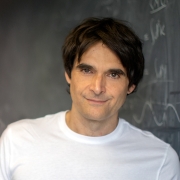Peacocks, Eye Tracking, and the Brains Behind Decisions
How do male peacocks size up their competition? Not by looking at the brightly colored tail feathers and upper eyespots for which these birds are known, but instead by focusing on their lower feathers and legs. The birds also pay more attention when their competitors shake their tails and move rather than when they are sitting still. That’s according to new research from Penn Integrates Knowledge professor Michael Platt and Jessica Yorzinski, a former postdoctoral fellow of Platt’s and now an assistant professor at Texas A&M University. They published their findings in the Journal of Experimental Biology.
This is the latest work in a quest to better gauge how animals, such as lemurs, monkeys, and even humans, acquire information about the surrounding world, combine that knowledge with internal decision-making mechanisms, and respond accordingly.
“One of the ways that we go about understanding how we make decisions is to measure precisely what people and other animals use in terms of visual information to guide subsequent decisions,” says Platt, who is a professor of psychology. “So we utilize what are now known as eye-tracking goggles.”
For humans, that essentially equates to a pair of funky-looking eyeglasses. A camera at its outside-facing midpoint offers the view of what the person wearing them sees. On the inside sit an infrared camera and an infrared illuminator, the latter of which shines a light that disappears into the pupil and gets reflected in the cornea’s layers. A computer then decodes, based on the reflective angles, where the eye is looking.
“It’s a nifty piece of engineering, but it’s basically just geometry,” Platt says.
It’s not quite as simple for animals, since they typically don’t have a head structure on which such headgear could sit. So for this experiment, Platt and Yorzinski employed a different model.
Click here to read the full story.





